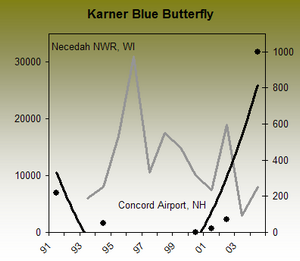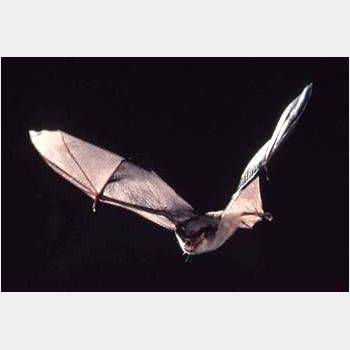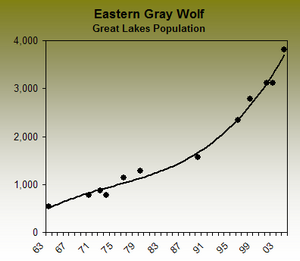Great Lakes Region
Species and Description
(click for a detailed technical account) |
Trend
(click to view literature citations and larger graph) |
States
(current and historic range)
|
Red wolf
Canis rufus
 Hunting and habitat loss reduced the red wolf to fewer than 100 individuals by 1970 and by 1980 the species was considered extinct in the wild. In 2003, approximately 100 red wolves in 22 packs existed in the wild with another 157 wolves held in captive breeding facilities. Hunting and habitat loss reduced the red wolf to fewer than 100 individuals by 1970 and by 1980 the species was considered extinct in the wild. In 2003, approximately 100 red wolves in 22 packs existed in the wild with another 157 wolves held in captive breeding facilities.
|
|
FL(b), MS(b), NC(b), SC(b), TN(b) --- AL(x), AR(x), DE(x), DC(x), GA(x), IL(x), IN(x), KY(x), LA(x), MD(x), MO(x), OH(x), OK(x), PA(x), TX(x), VA(x), WV(x) |
Kirtland's warbler
Dendroica kirtlandii
 The loss of young jack pine stands due to fire suppression and reduced nesting success due to brown-headed cowbird parasitism reduced the number of Kirtland's warbler territories to just 201 by 1971. In response to habitat restoration and control of cowbirds, the population began increasing in 1990, steadily growing to 1,701 pairs in 2007. The species recolonized Ontario and appeared for the first time Wisconsin in 2007, but its stronghold remains in Michigan. The loss of young jack pine stands due to fire suppression and reduced nesting success due to brown-headed cowbird parasitism reduced the number of Kirtland's warbler territories to just 201 by 1971. In response to habitat restoration and control of cowbirds, the population began increasing in 1990, steadily growing to 1,701 pairs in 2007. The species recolonized Ontario and appeared for the first time Wisconsin in 2007, but its stronghold remains in Michigan.
|
 |
FL(m), GA(m), KY(m), MI(b), NC(m), OH(m), PA(m), SC(m), WV(m), WI(b) --- |
Arctic peregrine falcon
Falco peregrinus tundrius
 The use of DDT and other organochlorine pesticides resulted in reproductive failures in Arctic peregrines and caused their population to plummet. After DDT was banned, migration counts at the New Jersey Cape May Hawkwatch site saw the number of migrating Arctic peregrines increase from 103 in 1976, to 429 in 1992 (the species was delisted in 1994), to 1,017 in 2004. The use of DDT and other organochlorine pesticides resulted in reproductive failures in Arctic peregrines and caused their population to plummet. After DDT was banned, migration counts at the New Jersey Cape May Hawkwatch site saw the number of migrating Arctic peregrines increase from 103 in 1976, to 429 in 1992 (the species was delisted in 1994), to 1,017 in 2004.
|
 |
AL(m), AK(b), AZ(m), AR(m), CA(m), CO(m), CT(m), DE(m), DC(m), FL(m), GA(m), ID(m), IL(m), IN(m), IA(m), KS(m), KY(m), LA(m), ME(m), MD(m), MA(m), MI(m), MN(m), MS(m), MO(m), MT(m), NE(m), NV(m), NH(m), NY(m), NM(m), NJ(m), NC(m), ND(m), OH(m), OK(m), OR(m), PA(m), RI(m), SC(m), SD(m), TN(m), TX(m), UT(m), VT(m), VA(m), WA(m), WV(m), WI(m), WY(m) -- |
Whooping crane
Grus americana
 The whooping crane declined precipitously in the late 1800's and early 1900's due to hunting and habitat loss. It rebounded from 54 birds (48 wild and 6 captive) when listed as an endangered species 1967 to 513 (368 wild and 145 captive) in 2006. The whooping crane declined precipitously in the late 1800's and early 1900's due to hunting and habitat loss. It rebounded from 54 birds (48 wild and 6 captive) when listed as an endangered species 1967 to 513 (368 wild and 145 captive) in 2006.
|
 |
CO(m), FL(b), GA(m), IL(m), IN(m), KS(m), KY(m), MT(m), NE(m), ND(m), OK(m), SD(m), TN(m), TX(s), WI(b), WY(m) --- AL(x), AR(x), DE(x), DC(x), IA(x), LA(x), MD(x), MN(x), MS(x), MO(x), NJ(x), NC(x), OH(x), SC(x), UT(x), VA(x), WV(x) |
American peregrine falcon
Falco peregrinus anatum
 The use of DDT and other organochlorine pesticides resulted in reproductive failures in American peregrines and caused populations to plummet. After DDT was banned, the number of American peregrine pairs breeding in the U.S. increased from 324 in 1975 to 1,700 in 2000; the species was delisted in 1999. The use of DDT and other organochlorine pesticides resulted in reproductive failures in American peregrines and caused populations to plummet. After DDT was banned, the number of American peregrine pairs breeding in the U.S. increased from 324 in 1975 to 1,700 in 2000; the species was delisted in 1999.
|
 |
AL(m), AK(b), AZ(b), AR(m), CA(b), CO(b), CT(b), DE(b), DC(m), GA(b), ID(b), IL(b), IN(b), IA(b), KS(m), KY(b), LA(m), ME(b), MD(b), MA(b), MI(b), MN(b), MS(m), MO(m), MT(b), NE(b), NV(b), NH(b), NY(b), NM(b), NJ(b), NC(b), ND(m), OH(b), OK(m), OR(b), PA(b), RI(b), SC(b), SD(b), TN(b), TX(b), UT(b), VT(b), VA(b), WA(b), WV(m), WI(b), WY(b) - |
Karner blue
Plebejus melissa samuelis
 The larvae of Karner blue butterflies feed exclusively on wild lupine, for which habitat has been destroyed by development and fragmentation, or degraded by successional changes. The Karner blue has stabilized in many of the 12 states it historically occurred, particularly Michigan, and has been successfully reintroduced in NH, OH, and IN The larvae of Karner blue butterflies feed exclusively on wild lupine, for which habitat has been destroyed by development and fragmentation, or degraded by successional changes. The Karner blue has stabilized in many of the 12 states it historically occurred, particularly Michigan, and has been successfully reintroduced in NH, OH, and IN
|
 |
IN(b), MI(b), MN(b), NH(b), NY(b), OH(b), WI(b) --- IL(x), IA(x), ME(x), MA(x), PA(x) |
American burying beetle
Nicrophorus americanus
 Although the cause of the American burying beetle's drastic decline (the beetle is absent from 90% of its historic range) is not well understood, it is thought to be due to disturbances in the food chain. Captive breeding and reintroduction efforts increased the total number of captive and introduced populations from one in 1990 to six in 2005. Although the cause of the American burying beetle's drastic decline (the beetle is absent from 90% of its historic range) is not well understood, it is thought to be due to disturbances in the food chain. Captive breeding and reintroduction efforts increased the total number of captive and introduced populations from one in 1990 to six in 2005.
|
 |
AR(b), KS(b), MA(b), NE(b), OH(b), OK(b), RI(b), SD(b), TX(b) --- AL(x), CT(x), DE(x), DC(x), FL(x), GA(x), IL(x), IN(x), IA(x), KY(x), LA(x), ME(x), MD(x), MI(x), MN(x), MS(x), MO(x), MT(x), NH(x), NY(x), NJ(x), NC(x), ND(x), PA(x), SC(x), TN(x), VT(x), VA(x), WV(x), WI(x) |
Gray bat
Myotis grisescens
 Because gray bats are found in just eight caves, disturbance and vandalism of maternity and hibernacula caves is the main threat to the species. After listing in 1976, the number of gray bats continued to decline to a low of 1.5 million in 1992, but numbers then began to increase and reached 2.5 million in 2003 when the U.S. Fish and Wildlife Service announced an intent to downlist the species. Because gray bats are found in just eight caves, disturbance and vandalism of maternity and hibernacula caves is the main threat to the species. After listing in 1976, the number of gray bats continued to decline to a low of 1.5 million in 1992, but numbers then began to increase and reached 2.5 million in 2003 when the U.S. Fish and Wildlife Service announced an intent to downlist the species.
|
 |
AL(b), AR(b), FL(o), GA(o), IL(o), IN(o), KS(o), KY(b), MS(o), MO(b), NC(o), OK(o), TN(b), VA(o), WV(s) --- |
Gray wolf (Eastern DPS)
Canis lupus (Eastern DPS)
 Hunting and persecution drove the gray wolf to near extinction with only a small number of wolves remaining in Minnesota and Michigan when the species was listed in 1974. Today, the total Great Lakes wolf population has increased to approximately 3,880 wolves up from less than 1,000 prior to listing. Hunting and persecution drove the gray wolf to near extinction with only a small number of wolves remaining in Minnesota and Michigan when the species was listed in 1974. Today, the total Great Lakes wolf population has increased to approximately 3,880 wolves up from less than 1,000 prior to listing.
|
 |
ME(o), MI(b), MN(b), WI(b) --- AR(x), CT(x), IL(x), IN(x), IA(x), KS(x), MA(x), MO(x), NE(x), NH(x), NY(x), NJ(x), ND(x), OH(x), PA(x), RI(x), SD(x), VT(x) |
Grizzly bear (Yellowstone DPS)
Ursus arctos horribilis (Yellowstone DPS)
 The killing of grizzly bears and the destruction and fragmentation of their habitat caused drastic population declines in the lower 48 states; by 1975 only six populations remained. The number of grizzly bears in the greater Yellowstone population has increased from an estimated 224 bears in 1975 to over 500 bears in 2005. The killing of grizzly bears and the destruction and fragmentation of their habitat caused drastic population declines in the lower 48 states; by 1975 only six populations remained. The number of grizzly bears in the greater Yellowstone population has increased from an estimated 224 bears in 1975 to over 500 bears in 2005.
|
 |
ID(b), MT(b), WA(b), WY(b) --- AZ(x), CA(x), CO(x), KS(x), MN(x), NE(x), NV(x), NM(x), ND(x), OK(x), OR(x), SD(x), TX(x), UT(x) |
Bald eagle (Continental U.S. DPS)
Haliaeetus leucocephalus (Continental U.S. DPS)
 The bald eagle declined throughout the Lower 48 states due to habitat loss and DDT application. The banning of DDT, increased habitat protection, and aggressive captive breeding and translocation programs caused the number of bald eagle pairs in the Lower 48 to soar from 416 in 1963 to approximately 9,789 in the latest census between 2004-2006. The bald eagle declined throughout the Lower 48 states due to habitat loss and DDT application. The banning of DDT, increased habitat protection, and aggressive captive breeding and translocation programs caused the number of bald eagle pairs in the Lower 48 to soar from 416 in 1963 to approximately 9,789 in the latest census between 2004-2006.
|
 |
AL(b), AZ(b), AR(b), CA(b), CO(b), CT(b), DE(b), DC(b), FL(b), GA(b), ID(b), IL(b), IN(b), IA(b), KS(b), KY(b), LA(b), ME(b), MD(b), MA(b), MI(b), MN(b), MS(b), MO(b), MT(b), NE(b), NV(b), NH(b), NY(b), NM(b), NJ(b), NC(b), ND(b), OH(b), OK(b), OR(b), PA(b), RI(b), SC(b), SD(b), TN(b), TX(b), UT(b), VT(b), VA(b), WA(b), WV(b), WI(b), WY(b) --- |
Great Lakes piping plover
Charadrius melodus (Great Lakes DPS)
 Early declines in Great Lakes piping plover populations were due to hunting, egg collecting and the millinery trade while conversion of nesting habitat to public recreation shoreline development caused later declines. When the Great Lakes piping plover was listed in 1985, only 19 pairs remained, but by 2005 there were 58 pairs and the plover's range had expanded to the south, east and west. Early declines in Great Lakes piping plover populations were due to hunting, egg collecting and the millinery trade while conversion of nesting habitat to public recreation shoreline development caused later declines. When the Great Lakes piping plover was listed in 1985, only 19 pairs remained, but by 2005 there were 58 pairs and the plover's range had expanded to the south, east and west.
|
 |
AL(s), FL(s), GA(s), LA(s), MI(b), MS(s), NC(s), SC(s), TX(s), VA(s), WI(b) --- IL(x), IN(x), MN(x), NY(x), OH(x), PA(x) |
| |
(b) currently breeds, (s) seasonally present, (m) migration route, (o) occasionally present, (x) extirpated
|
 |















PhillipColla.jpg)












